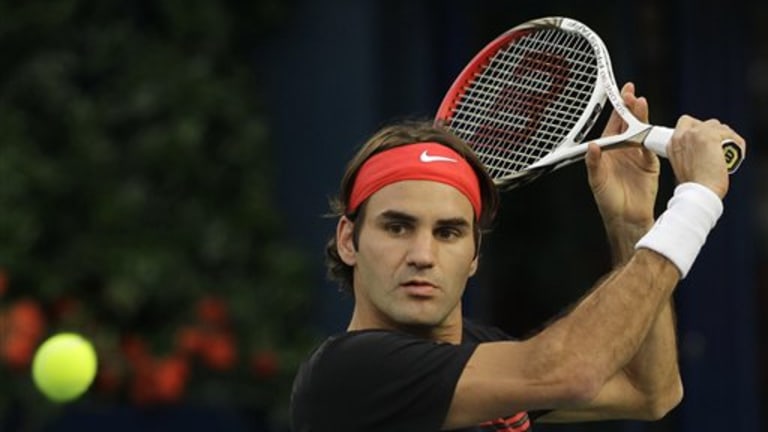by Pete Bodo
Roger Federer is approaching 31 years of age, by which time the reflexes and explosiveness of the typical pro are, along with some other qualities, in decline. It ought to be especially true on fast hard courts, but it's a testament to the all-time Grand Slam champion that the quick surface is the one on which he is still at his most dazzling.
Watching the current world No. 3 in Dubai this week, I repeatedly got the feeling that nobody—including Federer—understands just how heavy a price he's paid for having to play on courts that, even in his time, were getting slower and slower. He ought to sue the ATP and ITF for loss of employment opportunity. But he's won 16 Grand Slam titles!, you say. Well, there is that. . .
Still. The way Federer has been playing in Dubai (and at other locations for months on end now) is nothing less than eye-popping. On fast hard courts, those most basic talents—quickness, accuracy, reactions, timing—assume an importance they lack on slow courts, especially clay. On fast hard courts, Federer looks like Prometheus Unbound. And that's something that, frankly, I've never taken note of before.
I'm not sure why I haven't picked up on some of this stuff before now; can Dubai's hard courts really be that different? All I know is that above and beyond anything pertinent to his own situation, Federer also gives us an exclusive view of what tennis can be like when played in a certain way on a hard court.
Thus, these speculations are just as much about style and surface properties as they are about Federer per se.
Here's my beef with slow courts: As agreeable as it can be to see a gifted player hit 18 or 19 different shots in a rally, time and time again, the payoff for bold, aggressive play is inadequate. Actually, it's poor. As a result, stamina, prudent shotmaking, and defensive skill assume paramount importance, and we've just defined your typical tough out on clay—your David Ferrer. It can be fun watching a Ferrer at work, but a little of it goes a long way for me.
The low premium on bold play and the diminished role of the serve on slow courts change the way the game is played, greatly reducing the variety of shots we see. That's another point Federer has driven home, although not many other players well-suited to fast courts can do it so effectively.
It's no coincidence that the evolution of the two-handed backhand as the shot of choice went hand in hand with a decline in the use of slice and the slowing of the courts. For the record, I like the two-hander as a weapon, but I'll be the first to admit that it's a one-dimensional tool. As Rafael Nadal learned in the Australian Open final, the use of slice these days on most courts is an invitation to surrender the impetus in a point.
By contrast, if you've watched Federer this week, you've seen some stuff that looks like it belongs in a sepia-tinted photo or clattering newsreel. The sliced backhand has myriad manifestations, most of them neglected these days by the vast majority of players, from the chop to the well-timed block (call it a groundstroke volley) to the approach shot.
Approach shot? Who knew there's still such a thing in this era!
I don't know about you, but I get more pleasure out of watching a gifted player like Federer smack two or three balls off either wing to get a point over with than I do seeing those asp-ish shots tracked down and lofted back, as if his opponent is saying, "Try again. Three for a dollar." The higher incidence of errors, unforced and otherwise, and the greater number of shanks and Yeee-Haw! mishits that fast-court tennis coughs up bothers me not one bit. I prefer a blazing shootout to witnessing two men bludgeon each other to death.
On slower surfaces, any number of factors—including sheer luck—can have a far greater impact on the hold game than on fast surfaces. That's because of the premium on the serve, the single most important shot in the game, and the one on which the entire sensibility of the scoring system is based. As we gravitate more and more toward a rally-based game, it becomes that much harder to find clear turning points or even simple tactical or strategic explanations for what happened in any given match.
Generally speaking, a high-level match on a fast court between competent servers has two or three key moments per set. On a slow court, a high-level match often has a bewildering number of important moments. But you know how it goes: The more critical moments you have, the less critical each of those moments really is—until the very end. And this obfuscation in the plot of a match happens most often when the dividend for serving well is diminished. Rallying contests ultimately become pointless, except that someone will win because someone must.
I don't think anyone would argue that a player can reach into a much deeper bag of tricks on a fast court than on a slow one, which is one reason why clay never became the global surface of choice. But at the same time, the typical fast-court match usually produces a more streamlined, simple narrative (it has to be that way, when serving well all but guarantees a hold).
Slow-court tennis is like an automobile race in which every car is fitted with a governor that keeps it from going faster than any of the other vehicles. Someone will still win and everyone else will lose, but I prefer to see what happens when risk is rewarded.
